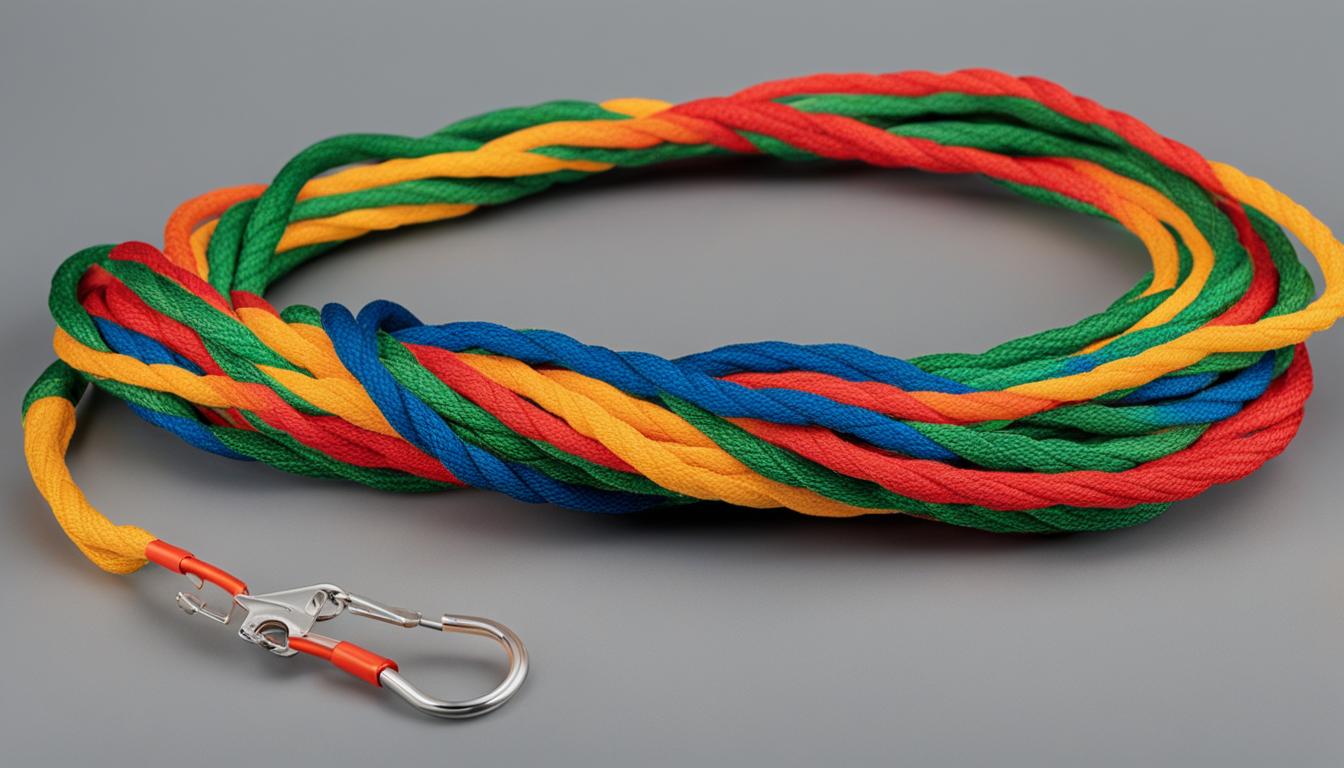Throw ropes are essential safety equipment for kayakers and other water sports enthusiasts. They play a crucial role in rescuing individuals who are in distress or swimming in whitewater. By learning the proper techniques for using throw ropes, you can ensure the safety of both yourself and others. In this section, we will explore how and when to use throw ropes effectively, including the necessary equipment, techniques, and best practices.
Key Takeaways:
- Throw ropes are essential safety equipment for kayakers and water sports enthusiasts.
- Using throw ropes properly is crucial for the safety of both the rescuer and the victim.
- Learning the necessary techniques and best practices for using throw ropes is important.
- Proper equipment, such as compact and waterproof throw ropes, is essential for effective usage.
- Understanding throw rope storage, deployment speed, length, durability, coiling techniques, strength, and reflective options enhances safety.
The Importance of Swiftwater Rescue Classes
Taking a swiftwater rescue class is essential for anyone who wants to learn how to use a throw rope effectively. These classes provide instruction on the proper techniques for throwing a throw bag, handling the rope, and conducting rescue scenarios.
Participants will learn important skills such as the defensive whitewater swimming position, which helps them stay safe and in control while swimming in fast-moving water. They will also learn how to handle a throw bag with precision and accuracy, ensuring that the rope reaches the intended target.
Swiftwater rescue classes teach participants about the different roles in a throw rope rescue. It is important for the victim to know how to properly position themselves and be ready to catch the throw bag. Additionally, backup rescuers learn how to assist the primary rescuer and ensure the safety of everyone involved in the rescue operation.
By attending swiftwater rescue classes, kayakers and water sports enthusiasts can develop the necessary skills and knowledge to respond effectively in emergency situations. These classes offer practical training and real-life scenarios, allowing participants to practice their throw rope skills and gain confidence in their abilities to handle rescue situations.
Remember, when it comes to safety on the water, being prepared is key. Taking a swiftwater rescue class will equip you with the skills and confidence to handle rescue operations effectively and ensure the safety of yourself and others.
Choosing the Right Throw Rope for Your Needs
When it comes to choosing a throw rope, there are several factors to consider. First, you need to determine the appropriate rope diameter for your needs. Thicker ropes, such as 3/8″, are commonly used by rafters and for more challenging rescue situations, while 5/16″ ropes are suitable for smaller crafts like kayaks and paddleboards.
The length of the rope should also be considered, with options ranging from 50′ to 85′ depending on the size of the waterway. It’s important to choose a rope length that allows you to reach the victim safely without putting yourself at risk. Keep in mind that longer ropes may be more difficult to handle and store.
Rope strength is another important consideration. Higher break strengths are recommended for more demanding whitewater conditions, as they provide added safety and reliability. Be sure to check the labeled breaking strength of the rope before making your selection.
| Throw Rope Types | Rope Diameter | Rope Length | Rope Strength | Throw Bag Styles | Personal Preference |
|---|---|---|---|---|---|
| Dynamic Floating | 5/16″ | 50′ | 2,000 lbs | Basic Bag | Quick Release Mechanism |
| Static Floating | 3/8″ | 60′ | 2,500 lbs | Waist-Worn Bag | Waist-Worn Bag |
| Dynamic Non-Floating | – | 75′ | 3,000 lbs | – | – |
In addition to rope specifications, there are various throw bag styles available in the market. Basic bags without additional features are commonly used and reliable. However, if you prefer quick-release mechanisms or waist-worn bags for easy access, there are options to suit your personal preference and convenience.
Ultimately, the choice of throw rope should be based on your specific needs and comfort. Take into consideration the type of water sports activity you engage in, the environment you’ll be in, and your own experience level. By selecting the right throw rope, you can ensure that you are prepared for any rescue situation that may arise.
Proper Techniques for Packing and Deploying Throw Ropes
Properly packing and deploying throw ropes is essential for effective rescue efforts in kayaking and other water sports. When it comes to packing a throw bag, the goal is to minimize the possibility of knots or tangles forming. One effective technique is coiling the rope in small, tight loops and stacking it on top of itself. This helps keep the rope organized and prevents it from tangling when it’s time to deploy.
When deploying a throw rope, there are different techniques to consider based on the situation. The overhand throw is a common method where you hold the bag with both hands and swing it over your head before releasing it towards the target. This technique provides good distance and accuracy. Another option is the underhand throw, where you hold the bag underhand and release it with an upward flick of the wrist. This technique is useful in situations where there are obstacles or low-hanging branches that could interfere with an overhand throw.
Practicing throw rope skills is crucial to improve accuracy and aim. Find a safe and open area to practice your throws, and aim for specific targets to enhance your precision. Regular practice helps build muscle memory and confidence, ensuring that your throw rope skills are sharp when it matters most. Additionally, always remember to regularly inspect your throw rope for any signs of damage and replace worn ropes promptly. This maintenance routine ensures that your throw rope remains reliable and effective in rescue situations.

In summary, mastering the proper techniques for packing and deploying throw ropes is essential for effective rescue efforts in kayaking. Coiling the rope tightly and stacking it in the throw bag helps prevent tangles and knots. When deploying the throw rope, consider using either the overhand or underhand throw technique based on the situation and obstacles present. Regular practice and maintenance of throw ropes are crucial to improving skills and ensuring their reliability. By honing your throw rope techniques, you can be better prepared to assist in rescue situations and ensure the safety of yourself and others.
Conclusion
In conclusion, ensuring the safety of yourself and others while kayaking is of utmost importance. By incorporating throw rope usage into your kayaking rescue techniques, you can effectively respond to emergency situations and potentially save lives. Remember that effective throw rope usage requires proper training and practice.
Swiftwater rescue classes offer invaluable opportunities to learn and refine your throw rope skills. These classes provide comprehensive training on various rescue scenarios, defensive swimming positions, accurate aiming, and the roles of both the victim and the backup rescuer in a throw rope rescue.
When selecting a throw rope, consider important factors such as rope diameter, length, and strength. Additionally, choose a throw bag style that suits your personal preferences and needs. Regular maintenance, including checking for damage and replacing worn ropes, is vital to ensure the safety and effectiveness of your throw rope.
By following these kayaking safety guidelines and continuously improving your throw rope skills through training, you can confidently navigate the waters with the knowledge that you are prepared to respond effectively and safeguard yourself and others in emergency situations. Stay safe, and happy kayaking!
FAQ
Are throw ropes necessary for kayaking?
Yes, throw ropes are essential safety equipment for kayakers and other water sports enthusiasts. They are used to rescue individuals who are swimming or in distress in whitewater.
Why is it important to learn the proper techniques for using throw ropes?
Learning the proper techniques for using throw ropes is crucial to ensure the safety of both the rescuer and the victim. It allows kayakers to perform successful throw rope rescues in real-life situations.
What will I learn in a swiftwater rescue class?
In a swiftwater rescue class, you will learn important skills such as defensive whitewater swimming positions, accurate aiming, and the role of the victim and the backup rescuer in a throw rope rescue. These classes provide valuable instruction on the proper techniques for throwing a throw bag, handling the rope, and conducting rescue scenarios.
How do I choose the right throw rope for my needs?
When choosing a throw rope, consider factors such as rope diameter, length, strength, and personal preferences. Thicker ropes are commonly used in more challenging rescue situations, while thinner ropes are suitable for smaller crafts like kayaks and paddleboards. There are also various throw bag styles available, including basic bags, bags with additional features, and waist-worn bags for easy access.
How should I pack and deploy a throw rope?
When packing a throw bag, coil the rope in small bits and stack it on top of itself to minimize the possibility of knots or tangles. When deploying the throw rope, practice techniques such as overhand throws and underhand throws to improve accuracy and aim. Regular maintenance of throw ropes, including checking for damage and replacing worn ropes, is crucial for their effectiveness.





